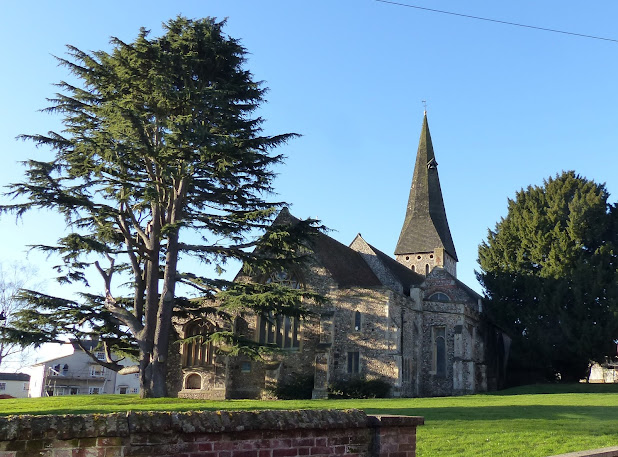Yesterday morning, enticed out by a bright sun and deep blue sky, and also reduced prices for old men on Tuesdays, I wandered around to the 'Esquire Barber Shop' for a haircut. A short prayer to ensure there were no queues succeeded, and one of the three busy lassies were soon tidying up the mess above my head.
Leaving behind enough gray hair to make a 'Dulux Dog' I wandered about our ancient city contemplating the history, the coffee bars and the women. The history we know, the coffee bars too dear, the women ignored me. I wondered how many knew that on that side of the road a Roman complex of some sort once existed. Could they imagine the Saxon Roundhouses down near the traffic lights? Did the realise that the High Street did not exist until probably the late 1200s when it was erected to ease the Bishop of London and his men on the way to their chapel along the road? I suspect few contemplated such things.
There are a few werewolves around here I can tell you.
Some towns do not appear to have much history in themselves but the people who have lived there often do. Notley Road, which leads you may guess to Notley, saw many men go off into the Great War, not all returned. Percy Lanham from No 29 died of wounds at St Omer, way behind the lines, and was buried there. His service was with the Army Service Corps, the people taking horse and cart full to ammunition and other supplies to the front. It is likely a shell brought him down, though in war anything can happen.
Just a wee but further down the road, passed what once was the 'Angel' Pub on the other side of the street once stood a house of a famous name. A man named Martin Kellogg lived there on Godlings Farm until he took off for the USA in the 1600s. Possibly they were non-conformists and thought New England would be a free place to live. Among the descendants of the Kellogg's 8 or 9 generations down, we find John Wayne and Clint Eastwood have connections. Whoever they are. The one we all know however, is William Keith Kellogg, a Seventh Day Adventist, like his family at the time. He joined his brother John at his sanitorium, run on healthy vegetarian lines, until, after some problems, beginning what we now know as 'Kellogg's Corn Flakes.'
This cereal was supposed to trap the sun in the corn and pass on the health benefits to the people. You may question this, I find the packet tastes better myself. Still, William was born in 1860 and died in 1951, so his health was good for a long time.
All this beginning, amongst much else, in Braintree!
One item noticed most days and not completely taken in is the pillar box. A system for collecting stamped mail designed by William Trollope the novelist. He was in charge of the Post Office in Ireland. He did not get on with Rowland Hill, the top man who had developed the 'Penny Post,' but top men do not get on with one another often, do they? Trollope travelled constantly and wrote many of his books while on the train. As even today writing is not always easy on a moving train I wonder how he managed so well? His books are very thick, this is because the 'Lending Library' charged money on each lend, and two volumes were not advantages to the shop. Books to be used by the library, the best Victorian way to be seen, had therefore to come in three volumes or were rejected. Trollope was not the only writer to grumble at this.
The box bears the letter 'GR,' indicating the box was built in the reign of King George. He reigned from 1910 - 1936, and is not to be confused with King George VI who reigned from 1936-1952. His stylised GR includes a VI above the letters. We await the introduction of King Charlies Post boxes. I wonder what they will do re the ones in Scotland?
In Scotland boxes did not have 'EiiR' as Scotland did not have a 'Queen Elizabeth' before 1952. The Crown was used instead. This is because many complained, and Westminster ignored them, until a box in Craigmillar was removed by a wee stick of Gelignite. The PM at the time, Churchill, decided 'something must be done.'






4 comments:
People miss so much when not interested in the history of the place where they live.
We have an example here, which would make a wonderful tourist destination.
In colonial times, produce from the Central Valley had to use a narrow mule path to reach the Pacific coast then shipped to the Spanish colonies in Latin America proper. It was the only path, over mountains, through jungle, and perilously slippery....
Part of that path goes through our canton...but is anyone interested? No.
Equally, when this area was settled in the late nineteenth century the R.C. bishop of the time encouraged the building of churches, to keep the populace on the straight and narrow. Result? Some beautiful wooden churches...tiny and lovely. Anyone interested in their history? No.
Fly, I cannot see why that canny be made into a tourist hotspot. It has much to see and a good place for ramblers.
The money only goes to the big boys with their all inclusive resorts.
Even a little publicity would help, but there's also the factor that colonisation is now a dirty word.....
Fly, The big boys always win.
Post a Comment